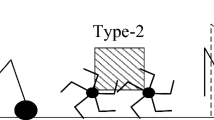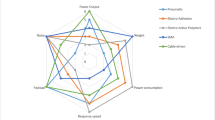Abstract
Small mobile robots with transformable wheels have recently emerged thanks to their increased mobility and maneuverability. When a high payload is applied to these robots, however, wheel transformation becomes difficult because they must directly overcome the payload’s weight. In this paper, we propose a wheel that can be transformed from its starting circular shape (radius, 56 mm) to a wheel with three legs (radius, 99 mm) under a high payload with low operating force. The key design principle of this wheel is to kinematically decoupled legs and passive locking. Its legs are kinematically decoupled but operated by a single air pump using a pneumatic channel connected to soft pneumatic actuators installed at each leg. Application of pressure causes the legs to behave like a coupled system through the pneumatic channel. With pressurization, the two legs that are not in contact with the ground easily emerge from body, and the leg in contact with the ground emerges once the wheel rotates. Once emerged, each leg is supported by a rigid pawl instead of by the soft pneumatic actuators. This setup enables the legs to be transformed independently with low air pressure, even under high payloads. It reduces system weight and the energy required to maintain the transformed shape. This legged wheel can overcome obstacles up to 2.9 times the radius of the wheel in its circular form, and wheel transformation can be accomplished with 85 kPa air pressure for payloads up to 1115 g.
Similar content being viewed by others
References
R. D. Quinn, J. T. Offi, D. A. Kingsley, and R. E. Ritzmann, “Improved mobility through abstracted biological principles,” Proc. of IEEE/RSJ International Conference on Intelligent Robots and Systems, pp. 2652–2657, 2002.
J. M. Morrey, B. Lambrecht, A. D. Horchler, R. E. Ritzmann, and R. D. Quinn, “Highly mobile and robust small quadruped robots,” Proc. of IEEE/RSJ International Conference on Intelligent Robots and Systems (IROS 2003), pp. 82–87, 2003.
U. Saranli, M. Buehler, and D. E. Koditschek, “Rhex: A simple and highly mobile hexapod robot,” The International Journal of Robotics Research, vol. 20, pp. 616–631, 2001.
G. Quaglia, D. Maffiodo, W. Franco, S. Appendino, and R. Oderio, “The Epi. q-1 hybrid mobile robot,” The International Journal of Robotics Research, 2009.
F. Michaud, D. Letourneau, M. Arsenault, Y. Bergeron, R. Cadrin, F. Gagnon, et al., “Multi-modal locomotion robotic platform using leg-track-wheel articulations,” Autonomous Robots, vol. 18, pp. 137–156, 2005. [click]
J. B. Jeans and D. Hong, “IMPASS: Intelligent mobility platform with active spoke system,” Proc. of IEEE International Conference on Robotics and Automation ICRA’09, pp. 1605–1606, 2009.
S. Hirose, “Variable constraint mechanism and its application for design of mobile robots,” The International Journal of Robotics Research, vol. 19, pp. 1126–1138, 2000. [click]
G. Endo and S. Hirose, “Study on roller-walker-energy efficiency of roller-walk,” Proc. of IEEE International Conference on Robotics and Automation (ICRA), pp. 5050–5055, 2011.
J. A. Smith, I. Sharf, and M. Trentini, “PAW: a Hybrid Wheeled-leg Robot,” Proc. of ICRA, pp. 4043–4048, 2006. [click]
C. C. Phipps, B. E. Shores, and M. A. Minor, “Design and quasi-static locomotion analysis of the rolling disk biped hybrid robot,” IEEE Transactions on Robotics, vol. 24, pp. 1302–1314, 2008.
K. Tadakuma, R. Tadakuma, A. Maruyama, E. Rohmer, K. Nagatani, K. Yoshida, et al., “Mechanical design of the wheel-leg hybrid mobile robot to realize a large wheel diameter,” Proc. of IEEE/RSJ International Conference on Intelligent Robots and Systems (IROS), pp. 3358–3365, 2010.
Y.-S. Kim, G.-P. Jung, H. Kim, K.-J. Cho, and C.-N. Chu, “Wheel transformer: A miniaturized terrain adaptive robot with passively transformed wheels,” Proc. of IEEE International Conference on Robotics and Automation (ICRA), pp. 5625–5630, 2013.
Y.-S. Kim, G.-P. Jung, H. Kim, K.-J. Cho, and C.-N. Chu, “Wheel Transformer: A Wheel-Leg Hybrid Robot With Passive Transformable Wheels,” IEEE Transactions on Robotics, vol. 30, pp. 1487–1498, 2014.
D.-Y. Lee, G.-P. Jung, M.-K. Sin, S.-H. Ahn, and K.-J. Cho, “Deformable wheel robot based on origami structure,” Proc. of IEEE International Conference on Robotics and Automation (ICRA), pp. 5612–5617, 2013.
D.-Y. Lee, J.-S. Kim, S.-R. Kim, J.-S. Koh, and K.-J. Cho, “The deformable wheel robot using magic-ball origami structure,” ASME 2013 International Design Engineering Technical Conferences and Computers and Information in Engineering Conference, pp. V06BT07A040-V06BT07A040, 2013.
Y. She, C. J. Hurd, and H.-J. Su, “A transformable wheel robot with a passive leg,” Proc. of IEEE/RSJ International Conference on Intelligent Robots and Systems (IROS), pp. 4165–4170, 2015.
S.-C. Chen, K.-J. Huang, W.-H. Chen, S.-Y. Shen, C.-H. Li, and P.-C. Lin, “Quattroped: a leg-wheel transformable robot,” IEEE/ASME Transactions on Mechatronics, vol. 19, pp. 730–742, 2014.
S.-C. Chen, K. J. Huang, C.-H. Li, and P.-C. Lin, “Trajectory planning for stair climbing in the leg-wheel hybrid mobile robot quattroped,” Proc. of IEEE International Conference on Robotics and Automation (ICRA), pp. 1229–1234, 2011.
T. Okada, W. T. Botelho, and T. Shimizu, “Motion analysis with experimental verification of the hybrid robot PEOPLER-II for reversible switch between walk and roll on demand,” The International Journal of Robotics Research, vol. 29, no. 9, pp. 1199–1221, 2009. [click]
Author information
Authors and Affiliations
Corresponding author
Additional information
Recommended by Guest Editor Sungwan Kim. This work was supported by the Technology Innovation Program (10051287, Development of fundamental technology of soft robotics for advanced soft gripper) funded by the Ministry of Trade, Industry & Energy (MOTIE, Korea). This work was supported by the National Research Foundation of Korea(NRF) Grant funded by the Korean Government(MSIP)(No.NRF-2016R1A5A1938472).
Sung-Sik Yun received his B.S. degree in mechanical engineering from Seoul National University, Seoul, Korea, in 2016. His current research interests include the design and fabrication of soft robotics and rehabilitation and assistive robotics.
Jun-Young Lee received his B.S. degree in mechanical engineering from Yonsei University, Seoul, Korea, in 2012. His research interests include soft robotics, mechanical designs, and biomimetics.
Gwang-Pil Jung received his B.S. degree in mechanical engineering from the Korea Advanced Institute of Science and Technology (KAIST), Daejeon, Korea, in 2010 and a Ph.D. degree from Seoul National University in 2016. His current research interests include the design and fabrication of biologically inspired soft robots and novel mechanisms using smart materials, structures, and actuators.
Kyu-Jin Cho received his B.S. and M.S. degrees from Seoul National University, Seoul, Korea, in 1998 and 2000, respectively, and a Ph.D. degree in mechanical engineering from the Massachusetts Institute of Technology in 2007. He was a Postdoctoral Fellow with the Harvard Microrobotics Laboratory until 2008. At present he is an Associate Professor of mechanical and aerospace engineering and the Director of the BioRobotics Laboratory at Seoul National University. His research interests include biologically inspired robotics, soft robotics, soft wearable devices, novel mechanisms using smart structures, and rehabilitation and assistive robotics. He has received the 2014 IEEE RAS Early Academic Career Award, the 2014 ASME Compliant Mechanism Award, the 2013 IROS Best Video Award, and the 2013 KSPE Paik Am Award.
Rights and permissions
About this article
Cite this article
Yun, SS., Lee, JY., Jung, GP. et al. Development of a transformable wheel actuated by soft pneumatic actuators. Int. J. Control Autom. Syst. 15, 36–44 (2017). https://doi.org/10.1007/s12555-016-0477-9
Received:
Revised:
Accepted:
Published:
Issue Date:
DOI: https://doi.org/10.1007/s12555-016-0477-9




